

Click on thumbnail image or highlighted text for a larger picture.
Table of Contents | Quick Index: | 17th century | 18th century | 19th century | 20th century | Architecture links | Fine Arts department home page
Click on any picture for an enlarged version.
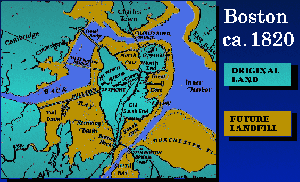 Superimposing a modern map of Boston over this original peninsula reveals
the extent of the landfill. Modern landmarks such a the Southeast expressway
and Storrow drive bear little relation to the original terrain.
Superimposing a modern map of Boston over this original peninsula reveals
the extent of the landfill. Modern landmarks such a the Southeast expressway
and Storrow drive bear little relation to the original terrain.
As late as 1775, little had changed in Boston. The most noteworthy early alterations to the landscape were the construction of the Long Wharf to the east, nearly one half mile in length, and the construction of a dam across the arms of the North Cove, creating a mill pond which harnessed tidal power to drive grist mills and sawmills.
A colored engraving of Boston from 1764, shows the prominence of the Long Wharf, projecting far into the bay. Boston was a busy port, but, it should be remembered, still a city of less than 16,000 population. Looking closer at this engraving, one can see the profiles of the Old South Church and Christ Church, or the Old North Church, both built in the 1720s.
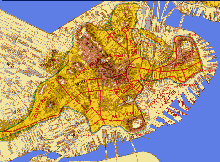 By 1820 landfill projects had begun, although the northern mill pond was
not yet filled in. The largest change to the landscape shown in this map
is the new dam across the Back Bay, meant to create a second tidal power
source.
By 1820 landfill projects had begun, although the northern mill pond was
not yet filled in. The largest change to the landscape shown in this map
is the new dam across the Back Bay, meant to create a second tidal power
source.
The trimount is commemorated in the modern name of Tremont Street. Mount Vernon was cut down early in the 1800s, and the soil was filled along Charles Street. Beacon Hill was next, cut down between 1807 and 1824; the soil from Beacon Hill helped fill in the Mill Pond in the North Cove. The North End was thus joined more solidly to the rest of Boston. Charles Bulfinch designed the pattern of streets for the new land of the Mill Pond; the outermost edge of that plan is now Causeway Street. Pemberton Hill was cut down rapidly in 1835, and the fill was dumped along the North side of Causeway Street, near the modern North Station.
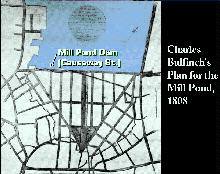
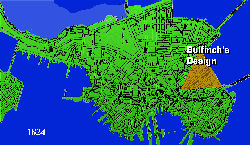
The primitive tools used to cut down the first hills of Boston help explain
the length of time required to cut down the hills, and the initial slow
pace of landfill projects. The reduction of the steep hills added more
land along the edges of the coves, and also made the hills themselves more
habitable.
As recently as 1830, Boston was still very much a marine city, with Quincy Market and the Custom House immediately adjacent to the harbor. And, of course, the Back Bay was still filled with water. The modern day visitor to Quincy Market is probably not aware that they are standing on the ancient shoreline of Boston Harbor.

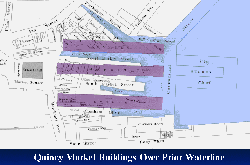
Boston Landfill -- Page 3
Boston Landfill -- Page 1
|
Slide Show, part 1 |
Slide Show, part 2 |
Slide Show, part 3 |
Slide Show, part 4 |
|
Slide Show, part 5 |
Slide Show, part 6 |
Slide Show, part 7 |
Slide Show, part 8 |
|
Slide Show, part 9 |
|||
|
|
|
|
  |
 |

|
 Other
Art and Architecture Web Links
Other
Art and Architecture Web Links
Boston College
Jeffery Howe, 1996